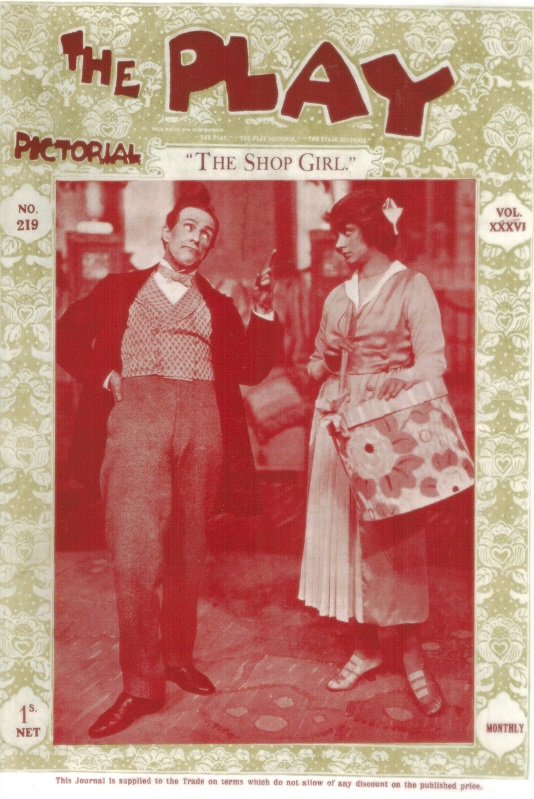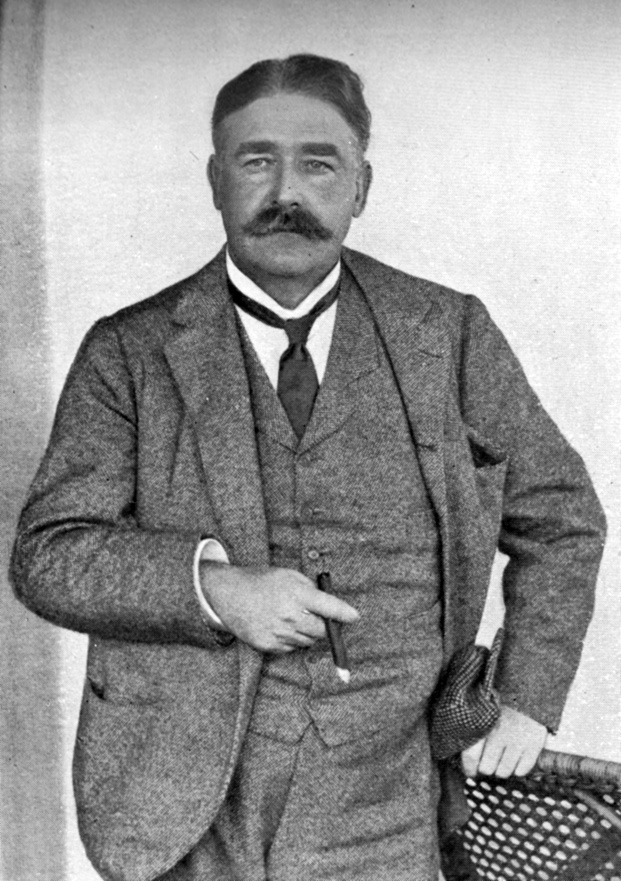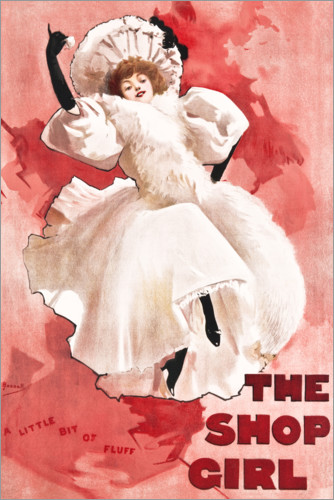Kevin Clarke / Kurt Gänzl
Operetta Research Center / Encylopedia of the Musical Theatre
22 June, 2020
The record label Palaeophonics is specialized in historic cast albums attractively packed as old The Play reprints of the respective shows. While looking at their Merry Widow and Madame Pompadour albums I stumbled upon The Shop Girl, the great London success that took operetta in Britian from Hervé and Offenbach and Gilbert & Sullivan to something new – before the Vienna hits by Lehár and Straus made a West End splash. On Palaeophonics you get 20 tracks ranging from orchestral selections played by The Gaiety Theatre Orchestra under Arthur Wood to Evelyn Laye and Roy Royston singing the famous songs and duets. Many of these numbers are forgotten today, even by operetta aficionados. So, to shed a bit of fresh light on The Shop Girl, we’ve asked Kurt Gänzl to explain what the “musical farce” in 2 acts by Henry J. W. Dam is all about. It has music by Ivan Caryll, and additional numbers by Adrian Ross and Lionel Monckton. Opening night was at the Gaiety Theatre in London on 24 November, 1894. Here is Mr. Gänzl’s article from The Encyclopedia of the Musical Theatre.

The cover of the Palaeophonics release of “The Shop Girl.” (Photo: Palaeophonics)
The Shop Girl is one of those shows which has been lumbered, in the past, by being dubbed ‘the first musical comedy’ by some of the theatre’s more facile commentators. It was, of course, nothing of the kind, any more than were George Edwardes’s earlier productions A Gaiety Girl and In Town or Fred Harris’s Morocco Bound – whose author, Arthur Branscombe, became a figure of fun with his conversational gambit ‘when I invented musical comedy …’ – and Go-Bang, or even the touring phenomenon The Lady Slavey which also preceded it.

Photograph of George Edwardes by Ellis & Walery, from the 1914 edition of Cellier & Bridgeman’s “Gilbert and Sullivan and Their Operas.”
The Shop Girl merely marked a change in style at London’s Gaiety Theatre where it was the first of a series of successful modern-dress musical productions (many retaining the ‘girl’ element of its title) which confirmed that theatre as the most popular light musical house in the West End during the turn-of-the-century years.
The death of Fred Leslie and the illness of Nellie Farren, the two most important Gaiety stars of recent years, helped to put an end to the era of New Burlesque which George Edwardes had fostered with such huge international success at his theatre, and the success of his In Town and A Gaiety Girl (both produced at other London theatres), up-to-date pieces full of smart, topical chat and dressed in fashionable modern clothes, led him to commission a like piece for the Gaiety to follow the indifferent burlesque Don Juan.

Advertisment for “A Gaiety Girl,” the Sidney Jones hit.
For some reason, he went for his text not to A Gaiety Girl’s Owen Hall but to an obscure American journalist and small-time playwright, Henry Dam, and for his score to Ivan Caryll, recently triumphant with Little Christopher Columbus, rather than to the Gaiety’s house composer, Meyer Lutz, the writer of so many celebrated burlesque scores for him. He also put together an almost wholly fresh company, with only comic Edmund Payne, dancers Katie Seymour, Topsy Sinden and Willie Warde and character lady Maria Davis remaining from the Don Juan principals.
The book which Dam concocted was not precisely original in its plot elements. Wealthy, expatriate John Brown (Colin Coop) is searching for his little lost daughter-cum-heiress and the search has been narrowed to the girls employed at the store run by Mr Hooley (Arthur Williams). When it seems that plumply pouting Ada Smith (Lillie Belmore) is she, Hooley swiftly proposes and Ada dumps her little fiancé, shopwalker Miggles (Payne), for a quick tie-up with the boss, only for the pair to discover that the real heiress is not Ada but soubrette Bessie Brent (Ada Reeve). Bessie marries her upper-class Charlie (Seymour Hicks) and Miggles consoles himself with duets with the pretty Miss Robinson (Katie Seymour). If the content of the libretto was old hat, it was, however, told in the style of the moment — crisp, modern dialogue with none of the wordplay or pantomime jokes of burlesque. Hicks and the music hall’s Miss Reeve played their juvenile rôles with bantering light comedy and without even one of those soulful duetting moments that were usually the province of the ‘romantic leads’ of a musical play, and the whole piece came out as decidedly smart and up-to-date.

“A little bit of fluff”? Post for “The Shop Girl.”
The show’s score of songs gave all the artists a chance to shine: Payne and Miss Seymour came out perhaps the best with a little oriental duo called ‘Love on the Japanese Plan’, George Grossmith in the incidental rôle of a mashing dude described himself in a Lionel Monckton number as ‘Beautiful, Bountiful Bertie’, Coop narrated his rise to millionaire status in the soon-popular ‘Brown of Colorado’, Lillie Belmore comically invented an early life for herself as ‘The Foundling’ and American soubrette Marie Halton, in a wholly incidental rôle called Dodo, supplied a slightly more sentimental moment with the soprano waltz song ‘Over the Hills’.
The most successful single song, however, was one interpolated by Seymour Hicks. Felix McGlennon’s ‘Her Golden Hair Was Hanging Down Her Back’ had been sung in the British music halls by Alice Leamar and subsequently pirated in America where Hicks heard it and, given the copyright laws of the time, annexed it for himself. Adrian Ross wrote new lyrics, and Hicks scored a great hit with the slyly suggestive song.
The hit cost, however, for when ‘Her Golden Hair’ turned out be a British, and not a ‘free’ American, song, McGlennon and Miss Leamar had to be heavily paid off for the privilege of its use. During the run the ever-changing cast interpolated many other successful songs (Leslie Stuart’s ‘My Lousiana Lou’, Fay Templeton’s ‘I Want Yer My Honey’, Paul Rubens’s début song ‘The Little Chinchilla’) but ‘Her Golden Hair’ and ‘Love on the Japanese Plan’ remained the two biggest song successes of the evening.
The Shop Girl was an enormous success at the Gaiety. ‘Shares in the ‘Gaiety Limited’ which could be had readily for five shillings each a few months back are now quoted at seventeen shillings and the stock is still going up’, reported one trade paper amazedly soon after the show’s opening. The show ran for 18 months and 546 performances and established itself as the model for the next decade of internationally popular Gaiety musicals. But The Shop Girl itself remained a favourite in spite of the popularity of its successors, touring long and late in the British provinces, and playing virtually every English-speaking theatre town from Calcutta to Johannesburg to Sydney and New York.
Edwardes sent his own company to America – a very starry affair with Hicks, Grossmith, Ethel Sydney and his new discovery, Connie Ediss (Ada), at its head — where it played 72 performances on Broadway as part of a national tour, and another to Australia where Harry Monkhouse, Louis Bradfield, Fred Kaye and Decima Moore played the show in a Gaiety repertoire season. The Shop Girl found sufficient success in this visit for J C Williamson to mount his own Australian production a decade later. Florence Young played Bessie and helped herself to ‘Over the Hills’, leaving soprano Margaret Thomas (Dodo) to re-equip with a Teresa del Riego number called ‘The Man in the Moon’, whilst George Lauri (Miggles), Rose Musgrove (Miss Robinson) and W S Percy (Bertie) supplied the fun and Clara Clifton as Ada borrowed ‘Class’ from The Silver Slipper in a score which was something of a paste-up job of hits from London musical comedies.
The Shop Girl, however, went further than the round of English-speaking stages. La Demoiselle de magasin accomplished the rare exploit for an English-language show of being produced in France, at the Olympia Music Hall, where café-concert diva Mdlle Micheline starred as Bessie alongside Messieurs Berville (Houley), Maréchal (Migles) and Danvers (Charley) in a spiced-up version by Maurice Ordonneau which gave ‘Love on the Japanese Plan’ to Bessie and Charley, and introduced a ‘Chrysanthemum Dance’ divertissement for the big 16 of the Olympia’s ballet. This production was followed by a Die Ladenmamsell, at Vienna’s Theater in der Josefstadt (ad Carl Lindau). Frln Dworak was Bessie, Herr Rauch played Miggles, Otto Maran was Hooley, Viktoria Pohl-Meiser was Ada (now called Eva), Karl Pfann was rich Charley and there were a Puppenlied, a Cancan-Duette and a ten-part Tanz-Ensemble all composed by musical director Karl Kappeller added to the now rather bulging entertainment.
The most sizeable subsequent production of The Shop Girl, however, was back in London, at the new Gaiety Theatre. After Edwardes’s death, Seymour Hicks and Alfred Butt produced a revised Shop Girl (25 March 1920, ad Arthur Wimperis) with the score infiltrated by a bundle of new Herman Darewski songs and with Evelyn Laye (Bessie) and Alfred Lester (Miggles) starring. The show proved popular all over again, a quarter of a century and many, many more musicals in the same vein after its first appearance, and the new production added another 327 performances to the show’s West End tally.

Evelyn Laye, later in her career, photographed by Allan Warren (Photo: Wikipedia)
USA: Palmer’s Theater 28 October 1895; Australia: Princess Theatre, Melbourne, 25 May 1895; France: L’Olympia La Demoiselle de magasin 4 June 1896; Austria: Theater in der Josefstadt Die Ladenmamsell 5 February 1897.
To order the historic recordings of The Shop Girl on Palaeophonics, click here.
